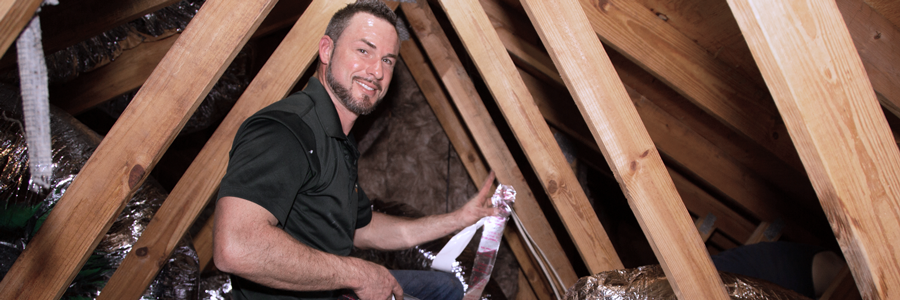
Are you inspired by the latest home improvement television shows? You may not want to live with your outdated kitchen or bathroom, but imagine being too hot or too cold in all the rooms in your home because of an older or rundown central heating and cooling system.
If you are remodeling or considering a home improvement project to improves your quality of indoor life, don’t overlook an inefficient heating and cooling system.
Renovating Your Indoor Comfort
Do home improvements and renovations really make you ‘feel’ good?
Your new, open-concept kitchen may not feel as good when sweat is dripping down your face because your air conditioner can't keep up with the summer heat. And the serenity of that beautiful, spa-like bathroom goes cold if your heating system can't keep that room warm.
Many home renovations may visually improve the look of your rooms, but they may not have any effect on your comfort level throughout your home. Jennifer Bertrand, interior designer for Lifetime Channel’s Military Makeover with Montel, says “The biggest trend in design is wellness. If your house is in order, your mind is in order.” A home improvement that includes updating a failing heating and cooling system should offer you this ability and help you ‘feel’ comfortable in your home.
HVAC industry manufacturers continue to design and incorporate technologies that may collectively improve your overall indoor comfort. These enhancements may make your home “feel” more comfortable than your current HVAC system. Today’s heating and cooling systems that include variable-speed options and advanced HVAC controls provide additional benefits for homeowners who prioritize indoor comfort.
For example, heating and cooling system with a variable speed fan automatically adjust the amount of conditioned air being delivered through the vents into your rooms. It gently ramps up or down according to your thermostat's demand. This feature can minimize the uncomfortable temperature peaks and valleys often found with the ON/OFF cycle of a single-speed HVAC unit. Once your rooms’ temperature is reached on the thermostat's setting, the lower speed can often maintain that set temperature longer than if the system was only able to operate or cycle at 100% on and 100% off. This allows for steady, consistent temperatures in your home.
Renovating Your Energy Bills
Home improvement shows often reveal the “updated home value” once renovations are complete. Upgrading your heating and cooling system could be a home renovation investment that saves you money on energy costs - month after month, year after year.
Upgrading to high-efficiency HVAC equipment may be a wise home improvement choice since heating and cooling costs can typically make up about 48% of your utility bill.1 If your house was built in the late 1990s or early 2000s, you might be using your home’s original heating and cooling system to keep your family comfortable. You may find that this aging system is less efficient than you would like, and/or in need of constant repairs.
If this sounds like your HVAC system, you may want to consider adding a new high-efficiency heating and cooling system to your renovation or home improvement list.
A licensed professional HVAC dealer should be able to tell you the energy-efficiency ratings of your current gas furnace, air conditioner and/or heat pump. These ratings may help you determine if you should update your HVAC equipment to stop throwing potential energy savings out the window.
The energy savings that you may get from a more efficient HVAC system could save you money on your monthly utility bill. When it comes to energy efficiency, the higher the rating number, the more energy efficient the equipment was designed to help lower your utility bill.
Since 2006, minimum energy-efficiency standards, HVAC technology, and performance features of heating and cooling equipment have collectively improved. As a homeowner looking to make home improvements, this can be a good thing for your comfort level and your wallet.
Smarthouse.org states that upgrading a gas furnace with a high-efficiency model may be a good investment.2 And if your air conditioner is over ten years old, you may save up to 40% of your cooling energy costs by replacing it with a higher efficiency model.3
Renovations that include a high-efficiency heating and cooling system may help you cut monthly energy cost for years and years to come. That sounds like a good home improvement option!
Peace of Mind
Living with a heating and cooling system that is nearing the end of its lifespan may become stressful, inconvenient, and unfortunately uncomfortable. In typical fashion, HVAC systems find a way of failing at the worst possible time… on weekends, holidays, or when you simply want to relax. And, if you are like most people, your family’s indoor comfort is a priority: especially when outdoor temperatures are extreme.
If you have depended on your current HVAC system for over a decade, you may want to establish a repair cost cutoff point. This means that you might want to add a heating and cooling system to your home improvement list if repair costs reach your set limit. If that’s the case in your home, start researching the available features and benefits of a new system.
Abrupt breakdowns and continuous heating and cooling repairs may start to add up - both financially and emotionally! If you are in considering a home improvement or renovation project, you may want to consider your year-round comfort level. Because, no matter how beautiful the floors and cabinets are, no one wants to be too hot or too cold in their home.

1 Department of Energy. (2019). Resident Program Solution Center. Retrieved from Energy Data Facts: https://rpsc.energy.gov/energy-data-facts
2 American Council for Energy-Efficienct Economy. (2015). Buying Tips. Retrieved from Smarter House: http://smarterhouse.org/cooling-systems/buying-tips
3 Department of Energy. (2018, Dec 28). Heating and Cooling. Retrieved from Energy.gov: https://www.energy.gov/heating-cooling